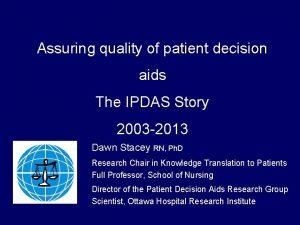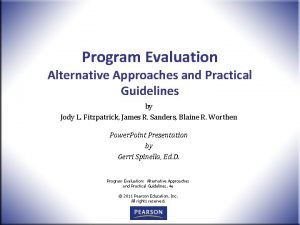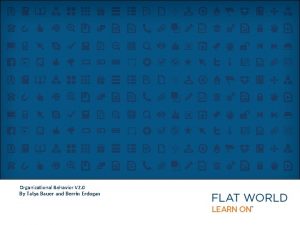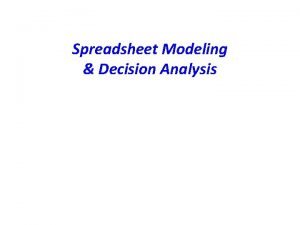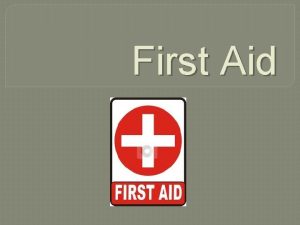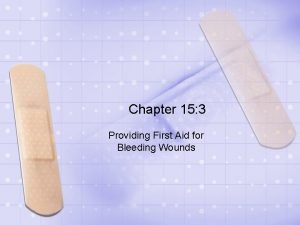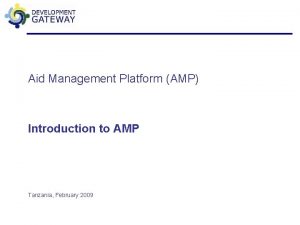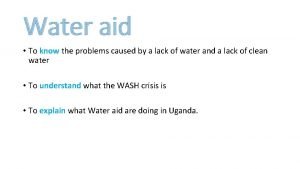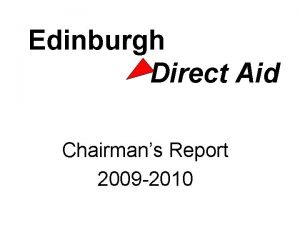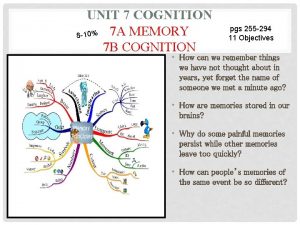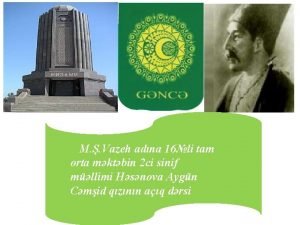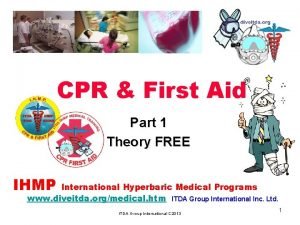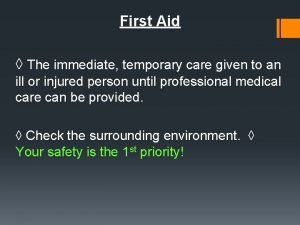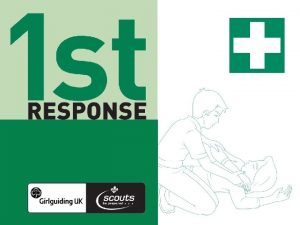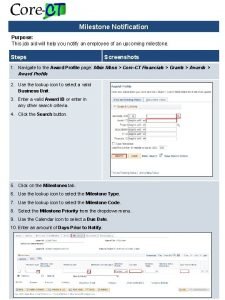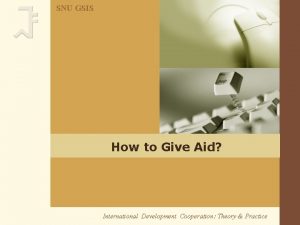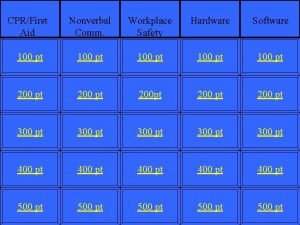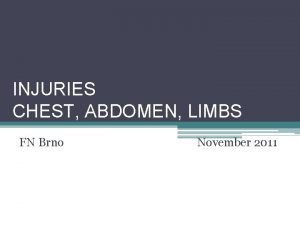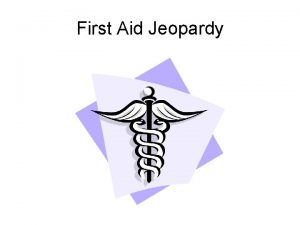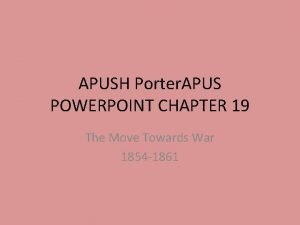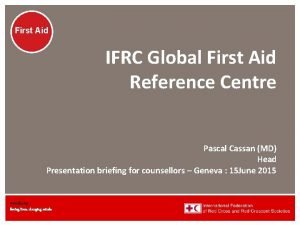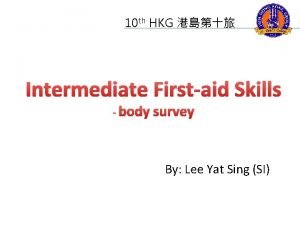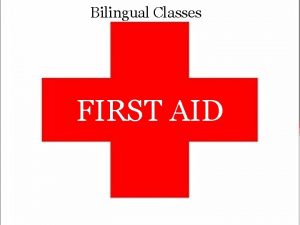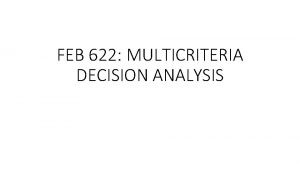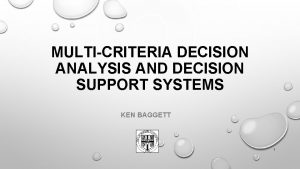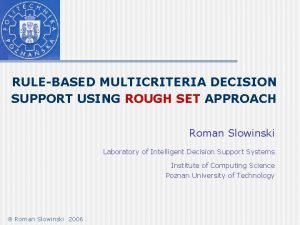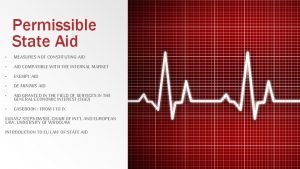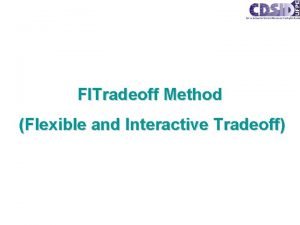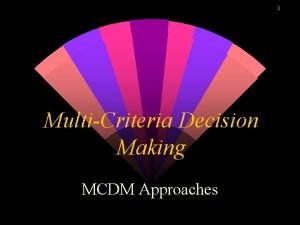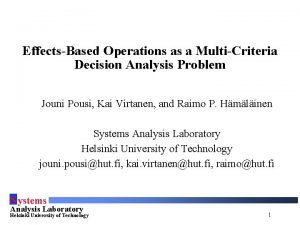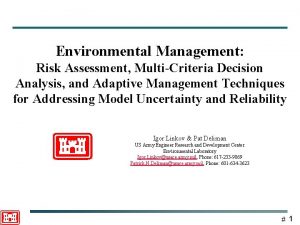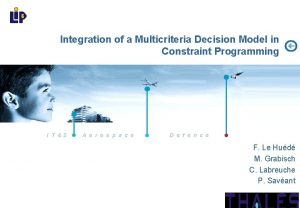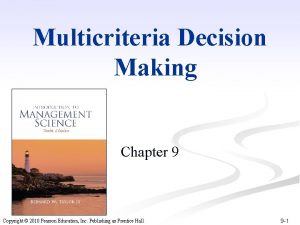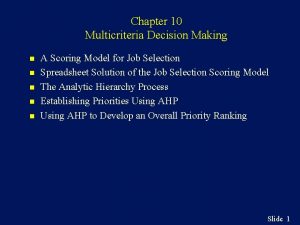Multicriteria Decision Aid the Outranking Approach Multicriteria decision












































































































- Slides: 108

Multicriteria Decision Aid: the Outranking Approach Multicriteria decision aid PROMETHEE & GAIA methods Decision Lab software March 2008 Bertrand Mareschal ULB – SMG & Solvay Business School bmaresc@ulb. ac. be http: //homepages. ulb. ac. be/~bmaresc 1

Course summary 1. Unicriterion vs. multicriteria models. 2. Multicriteria modeling: Basic concepts. 3. Multi-attribute utility theory (aggregation – “US school”). 4. Outranking methods (“French school”). 5. PROMETHEE & GAIA methods. 6. Decision Lab software – i. Vision project. March 2008 2

Decision making Real world • Social • Political • Economical • Industrial • Environmental • Military • Describe, • Understand, • Manage. 2 Approaches : • Qualitative approach, • Quantitative approach. March 2008 3

Decision aid Réalité Real world • Sociale • Social • Politique • Political • Economique • Economical • Industrielle • Industrial • Environnementale • Environmental • Militaire • Military Quantitative model • Possible decisions? • How to compare them? • Preferences, Objectives? March 2008 4

Decision aid Réalité Real world • Sociale • Social • Politique • Political • Economique • Economical • Industrielle • Industrial • Environnementale • Environmental • Militaire • Military Quantitative model • Approximation to real world! Ø Decision aid. March 2008 5

Some Decision or Evaluation Problems • • • Locating a new plant, a new shop, . . . Human resources management. Purchasing equipment. Assessing the quality of suppliers. Evaluating projects. Selecting an investment strategy. March 2008 6

Unicriterion vs multicriteria model • Unicriterion model: n Mathematically well-stated: w Optimal solution, w Complete ranking of the actions. n Socio-economically ill-stated: w Single criterion? Not realistic. w Notion of criterion: perception thresholds, … March 2008 7

Unicriterion vs multicriteria model • Multicriteria model: n Mathematically ill-stated: w No optimal solution, w No mathematical meaning. n Socio-economically well-stated: w Closer to real world decision problem, w Search for a compromise solution. March 2008 8

Chronology of multicriteria decision aid • • • 1968 : ELECTRE I method (B. Roy) 1972 : 1 st international conference in the USA 1973 : 1 st ULB thesis on MCDA 1975 : European working group 1977 : Charnes & Cooper: The main impetus for the burst of new applications seems to be associated with the evolution of public management science and its very natural orientation towards multiobjective formulation. • 1980 -85 : ± 12% of papers in European conferences. • 1992 : international journal JMCDA March 2008 9

Multicriteria table • Actions: n n Possible decisions, items to evaluate. • Criteria: n n quantitative, qualitative. March 2008 10

Multicriteria table Crit. 1 Crit. 2 Crit. 3 Crit. 4 … (/20) (rating) (qual. ) (Y/N) Action 1 18 135 G Yes … Action 2 9 147 B Yes … Action 3 15 129 VG No … Action 4 12 146 VB ? … Action 5 7 121 G Yes … … … … March 2008 11

Plant location Environm. (BEF) Costs (BEF) (impact) … Site 1 18 135 G … Site 2 9 147 B … Site 3 15 129 VG … Site 4 12 146 VB … Site 5 7 121 G … … … Investment March 2008 12

Purchase options Price (BEF) Reliability (days) Maintenance (estimate) … Product A 18 135 G … Product B 9 147 B … Product C 15 129 VG … Product D 12 146 VB … Product E 7 121 G … … … March 2008 13

A simple example Purchase of a car Objectives : • • • Economy (price), Usage (fuel consumption), Performance (power), Space, Comfort. March 2008 14

Multicriteria table • Best buy? • Best compromise? • Priorities of buyer? March 2008 15

Modeling… 1… 2… 3… 2. Define the criteria 1. Define the actions 3. Model the preferences March 2008 16

Defining the actions • Definition : Let A the set of actions. A can be defined: n n by extension: by enumeration of its elements. relatively small number of actions. by comprehension: by constraints on a set of decision variables. (Cf. linear programming) large number or infinity of actions. March 2008 17

Some properties of the set of actions A can be: • stable: a priori defined, doesn’t evolve. • evolutive: can evolve during the procedure. • globalised: mutually exclusive elements. • fragmented: combinations of actions are considered. March 2008 18

Defining the criteria • Definition: function g defined on A, taking its values in a totally ordered set, and representing an objective of the decision-maker. • Consistent family of criteria: n n Include all aspects of the decision problem, all the objectives of the decision-maker, Avoid redundancies. March 2008 19

Qualitative criteria • Qualitative scales: n n n Maximum 9 levels (7 ± 2) to ensure a consistent evaluation. Presence of a neutral level? Examples: w w Very good, Good, Average, Bad, Very bad Yes, No ++, +, 0, -, -++, +, -, -- • Underlying numerical scale (coding). March 2008 20

Modeling preferences • Problem: How to compare two actions a and b to each other? • A first model: 3 possible results: 1. 2. 3. March 2008 Preference: Indifference: Incomparability: a. Pb or b. Pa a. Ib a. Rb 21

Preference structures • Properties (logical): a. Pb not b. Pa a. Ib b. Ia Not a. Ra P is asymetrical I is reflexive I is symetrical R is non-reflexive a. Rb b. Ra R is symetrical • P, I and R define a preference structure if, for all a, b in A, one and only one of the following statements holds: a. Pb or b. Pa or a. Ib or a. Rb March 2008 22

Traditional preference structure (unicriterion) • Optimisation of a function g on A • Consequences: R is empty P is transitive I is transitive • Complete ranking. March 2008 23

The notion of indifference threshold • Problem: Indifference can be intransitive. Cf. Coffee cup paradox (Luce, 1956) • Introduction of an indifference threshold: • Quasi-order : P is transitive, but not I. March 2008 24

Other preference structures • Variable indifference threshold Interval order. • Preference + indifference thresholds Pseudo-order. • Models including incomparability Partial orders. • Valued preference structures. March 2008 25

Social choice theory • Problem: n n n A group of voters have to select a candidate among a group of candidates (election). Each voter has a personal ranking of the candidates according to his/her preferences. Which candidate must be elected? • What is the « best » voting procedure? • Analogy with multicriteria decision aid: n n Candidates actions, Voters criteria. March 2008 26

5 procedures… … among many others… 1. 2. 3. 4. 5. Relative majority. Condorcet. Second ballot (French presidential). Borda. Successive eliminations. March 2008 27

Procedure 1 : Relative majority 3 candidates: Albert, Bruno, Claire 30 voters: 11 10 9 voters A B C B C A A A 11 B 10 C 9 Albert is elected March 2008 28

Procedure 1 : Relative majority 3 candidates: Albert, Bruno, Claire 30 voters: 11 10 9 voters A B C B C A A March 2008 A 11 B 10 C 9 Problem: B and C preferred to Albert is elected A by a majority of voters! 29

Marie Jean Antoine Nicolas de Caritat Marquis de Condorcet 1743 - 1794 March 2008 30

Procedure 2 : Condorcet 3 candidates: Albert, Bruno, Claire 30 voters: 11 10 9 voters A B C A C B B preferred to A B preferred to C C preferred to A 19 votes 21 votes 19 votes A Bruno is elected March 2008 31

Procedure 2 : Condorcet paradox 3 candidates: Albert, Bruno, Claire 9 voters: 4 3 2 voters A B C March 2008 B C A B A preferred to B B preferred to C C preferred to A 6 votes 7 votes 5 votes Nobody is elected!32

Procedure 3 : second ballot (French presidential election) 4 candidates: Albert, Bruno, Claire, Diane 63 voters: 22 21 20 voters B C D A A A C D B B March 2008 1 st tour: B and C 2 nd tour: C beats B (41 vs 22) Claire is elected 33

Procedure 3 : second ballot (French presidential election) 4 candidates: Albert, Bruno, Claire, 63 voters: Diane 22 21 20 voters B C D A C D March 2008 A D B A C B Claire is elected !!!. . . but A preferred to C A preferred to B A preferred to D 42 votes 41 votes 43 votes 34

Procedure 3 : second ballot (French presidential election) 3 candidates: Albert, Bruno, Claire 17 voters: 5 6 4 2 voters C A B B 1 st tour: A and B 2 nd tour: A beats B (11 vs 6) Albert is elected A B C A C March 2008 35

Procedure 3 : second ballot (French presidential election) 3 candidates: Albert, Bruno, Claire 17 voters: 5 6 4 2 voters C A B AB A B C BA B C Albert was elected 1 st tour: A and C 2 nd tour: C bat A (9 contre 8) Claire is elected ! Problem: non-monotonicity! March 2008 36

Jean Charles de Borda 1733 - 1799 March 2008 37

Procedure 4 : Borda 31 x 2 + 39 x 1 3 candidates: Albert, Bruno, Claire 11 x 2 + 11 x 1 81 voters: 30 29 10 10 1 1 voters voter A C C B A B 2 A 101 C A B C 1 B B B A C C A 0 C 109 Claire is elected! March 2008 Points Scores 33 39 x 2 + 31 x 1 38

Procedure 4 : Borda 3 candidates: Albert, Bruno, Claire 81 voters: 30 29 10 10 1 1 voters voter A C C B A B 2 A 101 C A B C 1 B B B A C C A 0 C 109 Points Scores 33 A preferred to C : 41 on 81 March 2008 39

Procedure 4 : Borda 4 candidates: Albert, Bruno, Claire, Diane 7 voters: 3 2 2 voters C B A Scores Points A D 2 A D C 1 D C B 0 March 2008 A 13 A B 12 B C 11 C D 6 D 3 B Albert is elected Rankin g 40

Procedure 4 : Borda 4 candidates: Albert, Bruno, Claire, Diane 7 voters: 3 2 2 voters C B A A C C B Scores Points A 6 C B 7 B C 8 A 2 1 0 Ranking Claire is elected March 2008 41

Borda (manipulation) 3 candidates: Albert, Bruno, Claire 34 voters: 12 12 10 voters Scores Points Bruno’s partisans generate A B C 2 the candidacy of x ( « fake B Acandidate A » )1 C C B 0 Ranking A 46 A B 36 B C 20 C Albert is elected March 2008 42

Borda (manipulation) 4 candidates: Albert, Bruno, Claire, x 34 voters: 12 12 10 voters A B C Scores Points x A 2 C A B 1 x C x 0 March 2008 A 68 B B 70 A C 42 C x 24 x 3 B Bruno is elected! Ranking 43

Borda (manipulation) 4 candidates: Albert, Bruno, Claire, x 34 voters: 12 12 10 voters A B C Scores Points x x 2 B A A 1 C C B 0 The fake candidate is elected! March 2008 A 58 x B 48 A C 30 B x 68 C 3 x Ranking 44

Procedure 5 : Eliminations successives • Tour-wise procedure. • Principle: Eliminate progressively the worst candidates, one by one, until only one is left. March 2008 45

Conclusion? 5 candidates: Albert, Bruno, Claire, Diane, Eric 25 voters: Relative majority Albert elected 8 7 4 4 2 Second ballot: voters voters Bruno elected A B E D C C D C E E D C D B E B C B E A A March 2008 Condorcet: Claire elected Borda: Diane elected Successive eliminations: Eric elected 46

Kenneth Arrow (Nobel prize in economy, 1972) • Impossibility theorem (1952): With at least 2 voters and 3 candidates, it is impossible to build a voting procedure that simultaneously satisfies the 5 following properties: n n n Non-dictatorship. Universality. Independence with respect to third parties. Monotonicity. Non-imposition. March 2008 47

Problematics Evaluations • n actions • k criteria a - choice: determine a subset of actions (the « best ones » ). - sorting: sort actions in predefined categories. - ranking: rank from the best to the worst action. - description: describe actions and their consequences. March 2008 48

Dominance and efficiency • « Objective » . • Based on a unanimity principle: • Efficiency: a is efficient if it is not dominated by any other action. • Problems: n n Dominance is poor (few dominances), Many actions are efficient. March 2008 49

Objections to dominance I a b g 1 g 2 a b 100 20 30 • a efficient • a preferred to b IV a b March 2008 g 1 II g 2 a b 100 30 20 100 • a and b efficient • a and b incomp. g 1 g 2 100 99 99 100 • a and b efficient • a and b indiffer. V a b g 1 III g 2 100 99 20 100 • a and b efficient • a preferred to b g 1 g 2 100 99 99 • a efficient • a and b indiffer. 50

Some characteristics for a good multicriteria method • Take into account deviations between evaluations. • Take scale effects into account. • Build either a partial (P, I, R) or a complete (P, I) ranking of the actions. • Stay sufficiently simple: n n no black box, no technical parameters. March 2008 51

A common approach: The weighted sum Criteria Actions or Decisions Weights of the criteria March 2008 52

A common approach: The weighted sum • Global value for a : V(a) = w 1 g 1(a) + w 2 g 2(a) + … • a is preferred to b if: V(a) > V(b) (if all criteria are to maximise) March 2008 53

Weighted sum: Example 1 • V(a) = 91 V(b) = 88 • Total and uncontrolled compensation of weaknesses by strengthes. March 2008 54

Weighted sum: Example 2 • V(a) = V(b) = V(c) = V(d) = 50 • Elimination of conflicts – Loss of information. March 2008 55

Weighted sum: Example 3 “Profit is approximately 2 times more important than time savings; 0. 7 for profit and 0. 3 for time savings. “ V(a) = 60 V(b) = 54. 6 a is ranked 1 st. March 2008 56

Weighted sum: Example 3 “Profit is approximately 2 times more important than time savings; 0. 7 for profit and 0. 3 for time savings. “ V(a) = 25 V(b) = 26. 6 b is ranked 1 st! March 2008 57

Weighted sum: Example 3 V(a) = 60 V(b) = 54. 6 a is ranked 1 st. V(a) = 25 V(b) = 26. 6 b is ranked 1 st. Significance of “weights” ! March 2008 58

Multicriteria decision aid • • • Multiattribute utility theory (“US school”). Outranking methods (“French school”). Interactive methods. Multiobjective programming. … Since 1970, numerous developments: conferences, papers, books, applications, software. . . March 2008 59

Multiattribute utility (MAUT) • Single synthesis criterion (aggregation). • Existence? • Construction? • Mathematical form? additive? March 2008 60

Multiattribute utility (MAUT) • Mode of construction : n n direct, indirect. • Information intensive for the decision maker. (quantity of information vs reliability? ). • Not flexible (sensitivity analyses). • Far away from the original decision problem structure: multicriteria unicriterion March 2008 61

Outranking methods • Majority principle • • (vs unanimity for dominance). Pairwise comparison of actions. Closer to the decision problem. ELECTRE methods (1968 -). PROMETHEE & GAIA methods (1983 -). March 2008 62

Different approaches g in Outrank Unicriterion approach Weighted sum Pairwise comparisons Foundation Mathematical Economical Compensation between criteria - Total Limited Scales - Linked to weigths of criteria Taken into account Conflict detection - No Yes March 2008 63

Decision aid methods • Supplementary information: Perception of scales Weighing of criteria • Analysis Procedure: Prescriptive approach: PROMETHEE Descriptive approach: GAIA March 2008 64

Comparison of 2 actions Crit. 1 Crit. 2 Crit. 3 Crit. 4 … (/20) (rating) (qual. ) (Y/N) Action 1 18 135 B Oui Action 2 9 147 Action 3 15 129 TB Non … Action 4 12 146 TM ? … Action 5 7 121 B Oui … … … … March 2008 M Oui= 6 Difference … … 65

Preference function Preference degree 1 Difference 0 Q Indifference threshold March 2008 6 P Linear Preference threshold 66

PROMETHEE Pref (Eco. , Lux. ) Pref (Lux. , Eco. ) Preference Deviation March 2008 Pref (Eco. , Lux. ) = 0, 3 = (1 + 0, 5 + 0 ) / 5 q Pref (Lux. , Eco. ) = 0, 5 = (0 + 1 + 0, 5 + 1 ) / 5 q 67

PROMETHEE Pref (Eco. , Lux. ) Pref (Lux. , Eco. ) Preference Deviation March 2008 Pref (Eco. , Lux. ) = 0, 43 = (2 x 1 + 0 + 2 x 0, 5 + 0 ) / 7 q Pref (Lux. , Eco. ) = 0, 36 = (0 + 1 + 0, 5 + 1 ) / 7 q 68

Pairwise comparisons • For each criterion gj : n n Preference function Pj Weight wj • Multicriteria preference degree of a over b : March 2008 69

Preference functions (as in Decision Lab software) Q Usual Q P Level March 2008 P « U » shape Q P Linear « V » shape S Gaussian 70

PROMETHEE Pref (Eco. , Lux. ) Pref (Lux. , Eco. ) Preference Deviation March 2008 Pairwise comparisons 71

Pairwise preference matrix p (a, b) March 2008 72

Pairwise preference matrix p (a, b) March 2008 73

Computation of preference flows March 2008 74

Preference flows b a • Leaving flow: (strength) • Entering flow: (weakness) • Net flow: March 2008 75

PROMETHEE • Rank decisions from the best to the worst ones. • Identify best compromise solutions. March 2008 76

PROMETHEE • PROMETHEE I : partial ranking • PROMETHEE II : complete ranking March 2008 77

Properties of the net flow • Net flow is centered: • Unicriterion net flows: March 2008 78

Outranking and rank reversal • Pairwise comparisons (outranking) not transitive due to the multicriteria nature of the decision problems: • Rank reversals unavoidable to obtain a transitive ranking (preorder). March 2008 79

Rank reversals in PROMETHEE • Limited: n n Net flow is the least squares optimal score with respect to rank reversal. Centered score s(a) that minimizes: March 2008 80

GAIA 1. Computation of unicriterion net flows (normalization) 2. Projection on a plane: • Graphical representation. • 5 dimensions! March 2008 81

GAIA • Discover conflicts among criteria. • Identify potential compromises. • Help to fix priorities. March 2008 82

GAIA • Actions: points • Criteria: axes = 90% March 2008 83

GAIA Price • Economic: 15 k€ • Tourism: 25, 5 -26 k€ • Sport: 29 k€ • Luxury: 35 -38 k€ = 90% March 2008 84

GAIA Power • Sport: 110 k. W • Luxury: 85 -90 k. W • Tourism: 75 -85 k. W • Economic: 50 k. W = 90% March 2008 85

GAIA PROMETHEE II ! • Actions: • Tour. B : 0, 26 points • Lux. 1 : 0, 06 • Criteria: axes • Tour. A : 0, 02 • Lux. 2 : 0, 00 • Econ. : -0, 15 • Decision • Sport : -0, 17 axis March 2008 = 90% 86

GAIA • Actions: points • Criteria: axes • Decision axis March 2008 = 90% !! only % information !! 87

PROMETHEE & GAIA methods • PROMETHEE : prescriptive approach n n Partial ranking (prudent) - PROMETHEE I Complete ranking (rating) - PROMETHEE II • GAIA : descriptive approach n n n Identification of conflicts among criteria. Profiles of actions. Fix priorities, sensitivity analysis (decision axis). March 2008 88

Home assignment • Set up a decision problem (up to 60 cells): min. 5 actions and 5 criteria. • Model the problem in Decision Lab. • Analyze the problem, including weight sensitivity analysis. • Produce a written report including: n n n Problem description, Preference modeling choices (scales, preference functions, weights), Complete PROMETHEE & GAIA analysis results, Conclusion. Max. 20 pages including figures. March 2008 89

Example 2 : Plant location • Actions: • Criteria: n n n 5 potential sites g 1 : Cost (investment) g 2 : Cost (operations) g 3 : Employment g 4 : Transportation g 5 : Environmental impact g 6 : Social impact March 2008 90

Evaluation table March 2008 • Criteria to minimize or maximize. • Different scales. • Quantitative or qualitative criteria. 91

Mono- and Multi-decision maker decision problems • Mono-decision maker : n n Single stakeholder (decision maker). Single evaluation table and preference structure. • Multi-decision maker: n n n Multiple stakeholders (including decision maker(s)). Multiple evaluation tables and preference structures. Looking for a consensus solution. March 2008 92

Example 2 • Four stakeholders (“decision makers”): n n Industrial (actual decision maker), Political authorities (regional), Environmental protection groups, Workers unions (social). • Four multicriteria tables. March 2008 93

Multicriteria matrix • Adapt multicriteria methods to multidecision maker problems. • Analyze conflicts among decision makers. • Help to achieve consensus solution. March 2008 94

Multi-scenarios model • Scenarios: n n Points of view, Hypotheses, … • Evaluations: n n ‘Objective’ criteria: common evaluations. ‘Subjective’ criteria: specific evaluations for each scenario. • Specific preference structures : n Weights, preference thresholds. March 2008 95

Multi-scenarios model • Adaptation of PROMETHEE: n n Individual rankings. Global (group) rankings taking into account a possible weighing of the scenarios. • Adaptation of GAIA: n Two distinct analyses. March 2008 96

Individual views • Single scenario: (fixed decision maker) • PROMETHEE rankings • “Classical” mono-decision maker GAIA plane: n n March 2008 Axes = criteria Points = actions 97

Multi-scenarios synthesis • Aggregating all scenarios (group). • PROMETHEE group rankings. • “Classical” GAIA-Criteria plane: n n March 2008 Axes = criteria Points = actions 98

GAIA-Criteria plane • Information: n Conflicts among criteria. • Pertinence: n March 2008 For mostly objective criteria. 99

Multicriteria synthesis • Aggregating all criteria. (group) • Global PROMETHEE rankings. • GAIA-scenarios plane: n n March 2008 Axes = decision makers Points = actions 100

GAIA-Scenarios plane • Information: n Global view of conflicts among scenarios (decision makers). • Origin of conflicts? n n March 2008 Definition of criteria, Subjective criteria, Definition of actions, Individual priorities. 101

March 2008 102

Group decision making • Up to 80% of upper management and executives working time spent in meetings. n n Time consuming (meetings, travel), High cost. • Limited efficiency of classical meetings: n n n Limited time allocated to each participant, Psychological restraints, Limited memory, … • Important stakes for organisations. March 2008 103

GDSS Rooms March 2008 104

Group Decision Support System • Use IT to improve the efficiency of meetings. n Electronic brainstorming. w Working in parallel. w Possible anonymity. w Automated report generation. n n Decision Aid. Voting procedures. • GDSS rooms or Internet. • Time savings and costs reduction. March 2008 105

Some applications at SMG • • • Financial evaluation of companies. Quality assesment of suppliers. Electricity production planning at Electrabel. Regional planning. Evaluation of urban waste management systems. • Environmental applications. • Therapeutical choice. • . . . March 2008 106

Decision Lab 2000 PROMETHEE & GAIA software http: //homepages. ulb. ac. be/~bmaresc/disk 1. htm • Data management: n n Qualitative scales, Categories of actions or criteria. • PROMETHEE I et II • GAIA • Sensitivity analysis tools: n n Walking weights, Stability intervals. • Multiple scenarios (GDSS) March 2008 107

i. Vision project • New software. • New visual tools: n n n Visual interactive preference modeling. Representation of PROMETHEE rankings. GAIA extensions: w GAIA-stick w GAIA-criterion March 2008 108
 Objectives of decision making
Objectives of decision making Financial management process
Financial management process St andrew medical centre
St andrew medical centre First aid merit badge first aid kit
First aid merit badge first aid kit How do information systems aid in decision making
How do information systems aid in decision making Ipdas
Ipdas Bandura's reciprocal determinism
Bandura's reciprocal determinism Cognitive approach vs behavioral approach
Cognitive approach vs behavioral approach Approach meaning in research
Approach meaning in research Michael treacy and fred wiersema
Michael treacy and fred wiersema Approach to system development
Approach to system development Multiple approach-avoidance
Multiple approach-avoidance Deep learning approach and surface learning approach
Deep learning approach and surface learning approach Datagram vs virtual circuit
Datagram vs virtual circuit Các châu lục và đại dương trên thế giới
Các châu lục và đại dương trên thế giới Từ ngữ thể hiện lòng nhân hậu
Từ ngữ thể hiện lòng nhân hậu Thế nào là hệ số cao nhất
Thế nào là hệ số cao nhất Tư thế ngồi viết
Tư thế ngồi viết Lp html
Lp html Diễn thế sinh thái là
Diễn thế sinh thái là Thế nào là giọng cùng tên
Thế nào là giọng cùng tên Hình ảnh bộ gõ cơ thể búng tay
Hình ảnh bộ gõ cơ thể búng tay Thể thơ truyền thống
Thể thơ truyền thống Cách giải mật thư tọa độ
Cách giải mật thư tọa độ Tư thế worm breton là gì
Tư thế worm breton là gì Khi nào hổ con có thể sống độc lập
Khi nào hổ con có thể sống độc lập đại từ thay thế
đại từ thay thế Vẽ hình chiếu vuông góc của vật thể sau
Vẽ hình chiếu vuông góc của vật thể sau Thế nào là mạng điện lắp đặt kiểu nổi
Thế nào là mạng điện lắp đặt kiểu nổi Các châu lục và đại dương trên thế giới
Các châu lục và đại dương trên thế giới Lời thề hippocrates
Lời thề hippocrates Bổ thể
Bổ thể Vẽ hình chiếu đứng bằng cạnh của vật thể
Vẽ hình chiếu đứng bằng cạnh của vật thể Quá trình desamine hóa có thể tạo ra
Quá trình desamine hóa có thể tạo ra Phép trừ bù
Phép trừ bù Alleluia hat len nguoi oi
Alleluia hat len nguoi oi Khi nào hổ mẹ dạy hổ con săn mồi
Khi nào hổ mẹ dạy hổ con săn mồi điện thế nghỉ
điện thế nghỉ Dot
Dot Thế nào là sự mỏi cơ
Thế nào là sự mỏi cơ Công thức tính thế năng
Công thức tính thế năng Thiếu nhi thế giới liên hoan
Thiếu nhi thế giới liên hoan Tỉ lệ cơ thể trẻ em
Tỉ lệ cơ thể trẻ em Fecboak
Fecboak Một số thể thơ truyền thống
Một số thể thơ truyền thống Phản ứng thế ankan
Phản ứng thế ankan Môn thể thao bắt đầu bằng từ chạy
Môn thể thao bắt đầu bằng từ chạy Sơ đồ cơ thể người
Sơ đồ cơ thể người Tư thế ngồi viết
Tư thế ngồi viết Thế nào là số nguyên tố
Thế nào là số nguyên tố đặc điểm cơ thể của người tối cổ
đặc điểm cơ thể của người tối cổ Trời xanh đây là của chúng ta thể thơ
Trời xanh đây là của chúng ta thể thơ Chó sói
Chó sói ưu thế lai là gì
ưu thế lai là gì Thẻ vin
Thẻ vin Cái miệng bé xinh thế chỉ nói điều hay thôi
Cái miệng bé xinh thế chỉ nói điều hay thôi Classical approach
Classical approach Decision usefulness theory
Decision usefulness theory Decision oriented evaluation approach
Decision oriented evaluation approach Vroom's decision tree approach
Vroom's decision tree approach Information approach to decision usefulness
Information approach to decision usefulness Decision tree approach
Decision tree approach Decision tree and decision table
Decision tree and decision table Abc in first aid
Abc in first aid Lyric hearing aid mri safety
Lyric hearing aid mri safety Stress first aid for firefighters
Stress first aid for firefighters Chapter 15:3 providing first aid for bleeding and wounds
Chapter 15:3 providing first aid for bleeding and wounds First aid patient assessment
First aid patient assessment Lvn program sacramento
Lvn program sacramento Aid management platform
Aid management platform Quotes about first aid
Quotes about first aid Water aid problems
Water aid problems Application of first aid
Application of first aid Edinburgh direct aid
Edinburgh direct aid Usi financial aid office
Usi financial aid office Suny fredonia financial aid
Suny fredonia financial aid Cocwa
Cocwa What effortful processing methods aid in forming memories?
What effortful processing methods aid in forming memories? Pervent
Pervent Yaxşılıq edən yaxşılıq görər
Yaxşılıq edən yaxşılıq görər Band aid project
Band aid project General first aid
General first aid Student aid.gov/fafsa
Student aid.gov/fafsa Immediate temporary care given to an ill or injured person
Immediate temporary care given to an ill or injured person Skill test in totaps is necessary when
Skill test in totaps is necessary when Kent state cost of attendance
Kent state cost of attendance Preserve life first aid
Preserve life first aid Charities aid foundation australia
Charities aid foundation australia Rcbc financial aid
Rcbc financial aid Job aid with screenshots
Job aid with screenshots Idaho legal aid services
Idaho legal aid services Chapter 8 emergency care first aid and disasters
Chapter 8 emergency care first aid and disasters Snu financial aid
Snu financial aid Cprfirst aid
Cprfirst aid Rice first aid
Rice first aid First aid jeopardy
First aid jeopardy Dr michael hoenig
Dr michael hoenig Archery training aid
Archery training aid Unit 15:3 providing first aid for bleeding and wounds
Unit 15:3 providing first aid for bleeding and wounds Mvnu student accounts
Mvnu student accounts First aid vocabulary
First aid vocabulary What is this
What is this Mürəkkəb sözlər nəyə deyilir
Mürəkkəb sözlər nəyə deyilir Mental health first aid
Mental health first aid Global first aid reference centre
Global first aid reference centre Call to adventure hercules
Call to adventure hercules Legal aid panel
Legal aid panel Rapid body survey first aid
Rapid body survey first aid Preserve life first aid
Preserve life first aid





